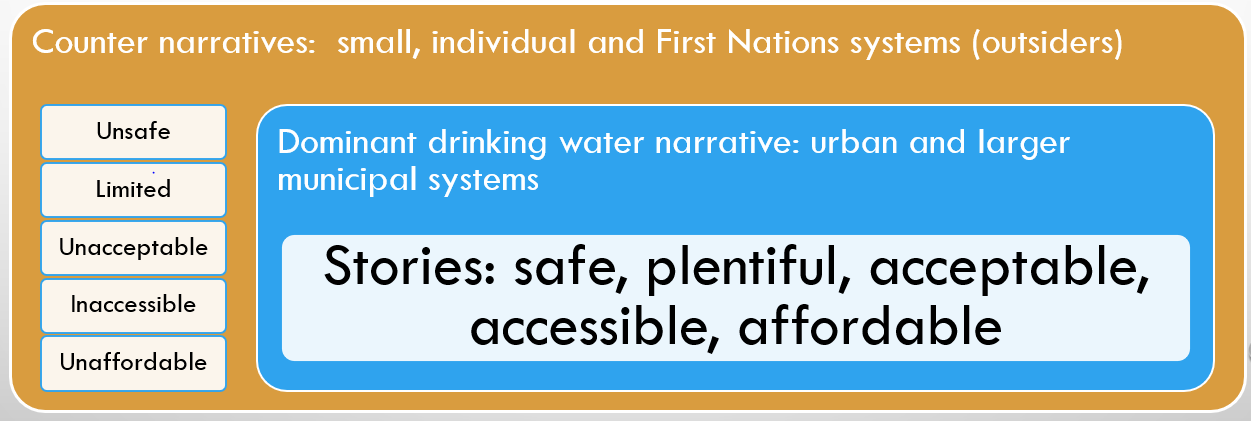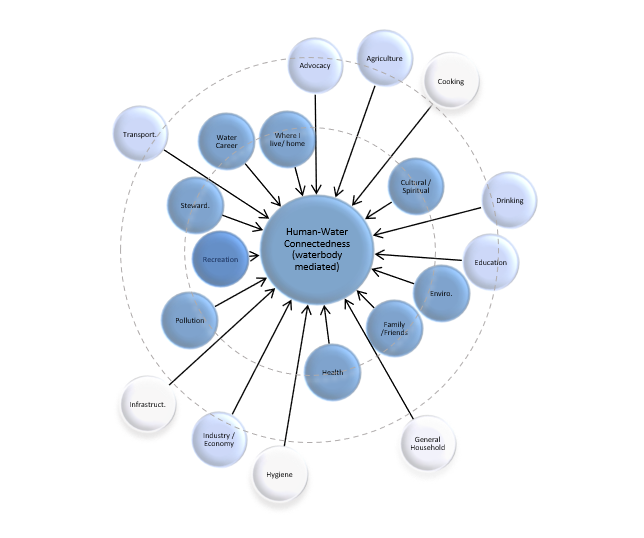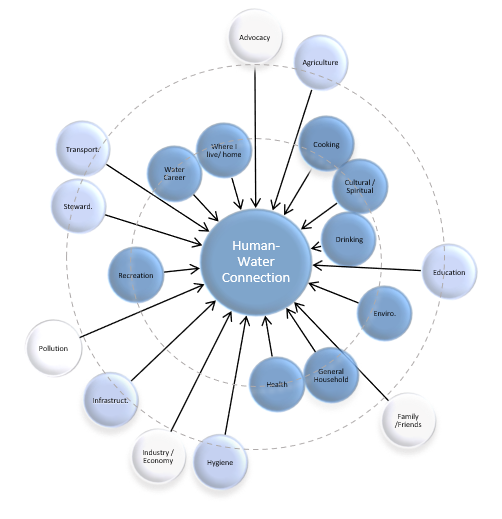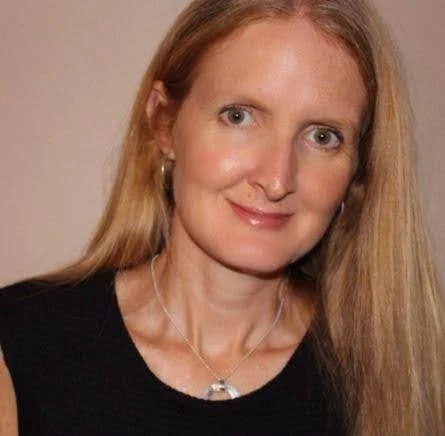Water Stories: An exploration of human-water connectedness in Ontario and the implications for water sustainability
Written by Tracey Ehl, June 2025
Back in 2014, a good number of years into my career, I took a diversion and went back to school. I was, and continue to be, very uncomfortable with the long-term drinking water issues that persist in the province and country, disproportionately affecting First Nations communities. After observing governments, organizations and communities coming together to solve very complicated water-related problems, and working with many talented professionals and community members, I could not get past the question, “Why is this still happening? Why are these issues so persistent?” My thinking was and is that this is a social challenge rather than a technical or financial one. Is it technically complicated? Yes. Is it costly? Yes. But so are many things that have enjoyed more sustainable progress. That leaves social. The hard on humanity cynic in me had some answers, but I wanted to spend some time reading and asking people about their relationship with water to find some clues. My research, which was finished nearly a decade later, focused on determining how Ontarians were connected to water and the implications for water sustainability in Ontario.
Why does connectedness matter?
Connectedness to nature is a critical factor in human survival and achieving sustainability (Schultz, 2002). Water connects people, health, wellness, culture, spirituality, nature, and the economy. Clean, safe water (potable water) and sanitation were recognized over a decade ago by the United Nations General Assembly (UN) as a basic human right, and more recently, the UN has also identified water sustainability and management as one of 17 sustainable development goals for all people in all countries. Water is inextricably connected to humans. Yet, in Ontario, Canada, a place with access to large freshwater reserves, robust regulatory frameworks, some investment by all levels of government, and a wealth of technical expertise, there are still thousands of people who experience disruption and contamination to this essential, life-sustaining resource, sometimes for decades.
When you consider the global water rights criteria (UNDESA, 2014), and the contrasting water stories that exist in Ontario, it is clear that there exists a water paradox (Figure 1). That is, there are very different narratives depending on who you are and where you live, and that’s a problem.
Figure 1: Ontario’s water paradox
Previous research has identified several troubling social trends regarding water which could help to explain this apparent water paradox in Ontario, including chronic underfunding of water-related infrastructure, environmental racism and colonialism, overconsumption, a complex regulatory regime, and a general indifference about water. Given that these factors are a result of human choices and priorities, it appears that many people may not perceive a deep connection to water. Since human connection to nature, including water, is a known predictive factor of social action toward sustainability, addressing the current challenges related to potable water requires that people are connected to water.
Research process
Three datasets were utilized in this mixed methods research, including content analysis of a rich database of personal water stories of Ontarians available digitally through the Watermark Project, a digital survey seeded through members of the Ontario Professional Planners Institute and the local chapter of the International Association for Public Participation, and a virtual roundtable discussion with people who had an interest diving a bit deeper into the topic. Demographically, the respondents closely mirrored the makeup of Ontario’s population in terms of geography and gender. Nearly all participants were non-Indigenous identifying.
Results
The findings reveal that all Ontarians are connected to water in some way. Nineteen different ways of being connected to water were identified. The concept of connectedness to water was approached in two ways. First, there was the concept of connectedness when considering a water body (Figure 2), and second, there was connectedness to water as a general concept (Figure 3).
In the figures, the ways of being connected are ordered alphabetically, starting in the 12:00 position. More predominant ways of being connected appear closer to the centre. Ways of being connected in the inner orbit are those with more than the median number of people expressing that particular connection. These are shown in a darker shade of blue. The outer orbit shows the ways of being connected that were at or below the median. These are shown in a lighter shade of blue. The ways of being connected that were not identified at all in the dataset are shown as ghost circles on the outside.
Figure 2: Waterbody Mediated Human-Water Connectedness Model
Figure 3: (Whole) Water Human-Water Connectedness Model
The results related to drinking water were very interesting. When asking people about how they were connected to water through a waterbody, drinking water was only mentioned once. This is interesting given that over 80% of Ontarians receive their household drinking water each day from surface water bodies (Ministry of Environment, Conservation and Parks, 2021). On the other hand, when asked about how they were connected to water as a general concept, drinking water emerged as the most prevalent way of being connected. Most striking was the connection to water through recreation, which was consistently predominant no matter which conceptualization of water was used.
The way people were connected to water was also analyzed looking at geographic, gender, temporal, and scale. This analysis revealed that people in the north are more likely to be connected to water because of where they live (i.e., in proximity to a waterbody), people in rural areas are more likely connected through health and general purposes, while urban dwellers are more likely to be connected to water through their careers and spirituality. Proportionately more males were associated with connections through a water career and the environment, while females were connected in a higher proportion through spirituality. It was also possible to identify through their water stories, that more people were connected to water in the past, than in the present. This finding supports previous research that concluded that people in Ontario take water for granted (RBC, 2015), an observation also made by a number of research participants about themselves.
When considering scale, it was interesting that the water connection related to sustainability were most often identified in the domain of “others” (i.e., community and provincial scale) and not mentioned as frequently or at all at the individual scale. Connectedness to nature is a determining factor for sustainable behavior in adults and the stronger the connection, the more likely the interest and effort invested (Perkins, 2010, Olivos et al., 2013, Geng et al., 2015, Restall & Conrad, 2015, Bruni et al., 2017, Barerra-Hernandez, 2020). To become more connected, people need “information about and experience in nature” (Zylstra et al., 2014, p. 119). What conclusion can be drawn by the lack of connection to water through sustainability? Maybe as water professional we have to meet people where they are? If people are connected to water in some strong way, real progress can be made in solving some of the chronic sustainability issues. This leads to the question, how?
An opportunity to shift the status quo through storytelling.
As a planner, I was curious about accessible ways to change how people are connected to water. Research shows that people learn as effectively from stories as they do from experiences.
“People ask for data, but they believe stories. People want real, messy, untold stories, imaginative tales – tangible change doesn’t happy through shallow stories, infotainment, mind numbing sustainability reports or greenwashing. Change only happens when we’re convinced by the intangible and undeniable truth told through a story”
(Leinaweaver, 2015, p. 5).
Maybe then stories hold the potential of overcoming barriers related to lack of or inconsistent experience with nature and water bodies. During this research, participants reflected that thinking about and telling their water story changed their connectedness to water, including in some cases, changing the ways they were connected and also strengthening existing or new connections. Respondents also offered a number of caveats to the use of storytelling, including the necessity for awareness of power dimensions so as to not perpetuate systemic, oppressive power imbalances, that the stories must be told in a compelling way, and are more effective if they are relevant and of interest to the story receivers.
I believe that storytelling as a method to support individual and community thinking and learning about water has the potential to broaden and deepen human connectedness to water, in turn contributing to a more sustainable future for both water and the people of Ontario.
Now what?
Besides a celebration on finishing this nearly 400-page partial answer to my burning question about how people in Ontario are connected to water, I am left with the question “now what?” This is a question I’d like to ask you. There are many individuals, organizations and initiatives doing lots of great thinking and acting around water justice and sustainability. Each on their own is not likely to address Ontario’s water paradox. What hints or cues can be taken from this research to collectively work in allyship with people whose water rights are not being met. How can we, together turn the tides? What is our transformative story?
Tracey Ehl, PhD, RPP, MCIP, CPF, MCP3
Principal
Ehl Harrison Consulting Inc.
Tracey El Bio:
Tracey is a Registered Professional Planner, a master certified public participation practitioner (MCP3) through IAP2, and a certified professional facilitator (CPF). Her professional practice focusses on environmental and strategic planning, facilitation, stakeholder engagement, environmental communications, and training.
Tracey has worked across sectors locally and internationally. Her project involvement focusses on complex and/or controversial projects in the areas of accessibility, aging, ethics and integrity, energy, sustainability, public water and wastewater system management, municipal planning, transportation and public transit, waste management, and community development. An important part of her role often involves establishing or continuing meaningful processes that engage across diversity to solve pressing challenges or leverage emerging opportunities. Most importantly, Tracey is mom to two great kids whose diversity and sense of justice has been a guide. She is an active volunteer in her community, a small business owner, and an aspiring voice actor, pilot and auto enthusiast who likes a good adventure.
